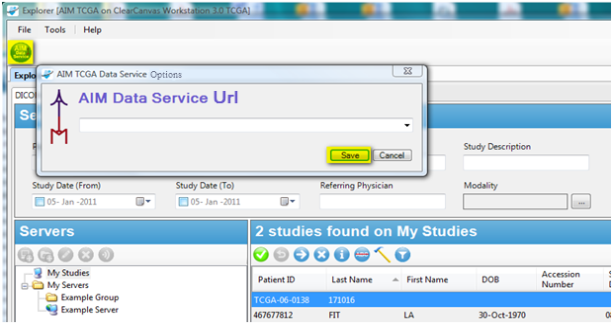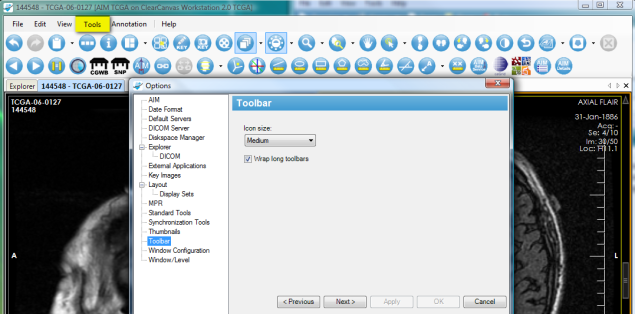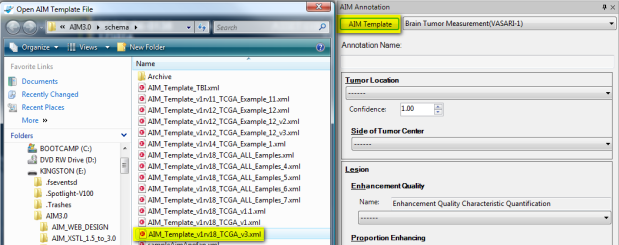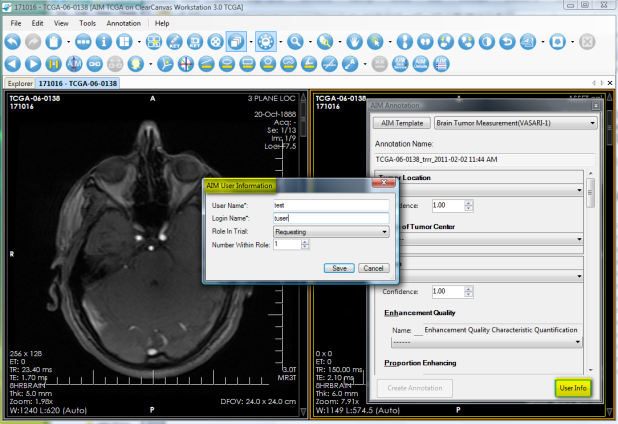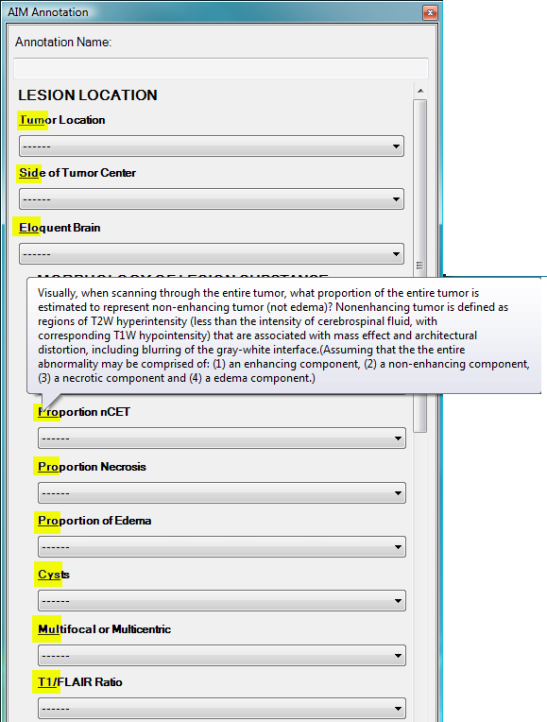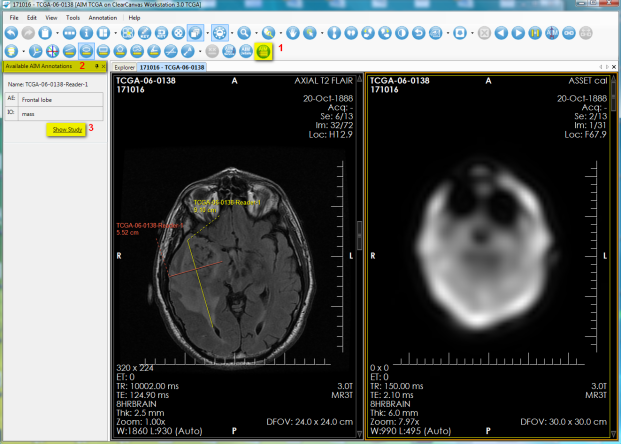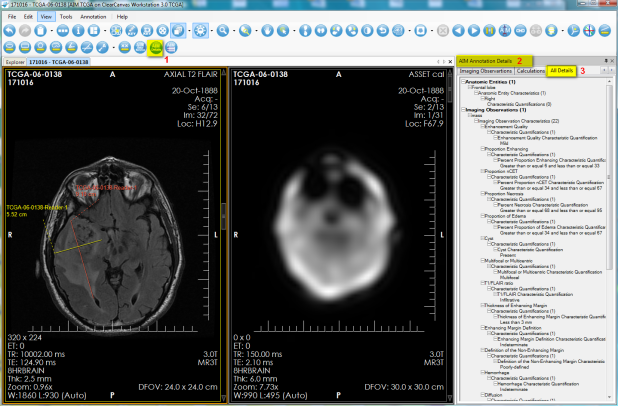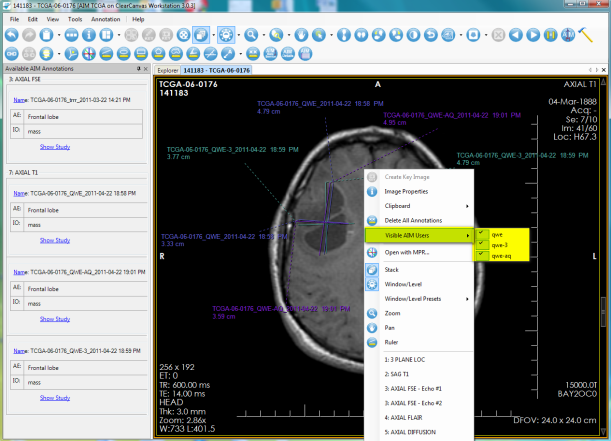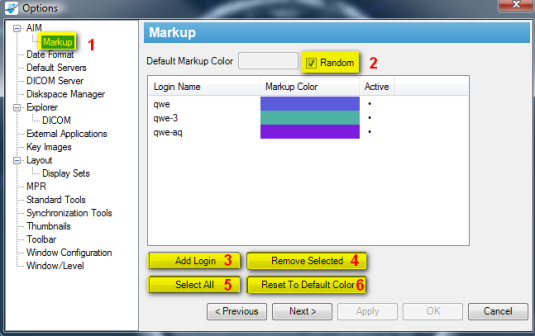 |
Page History
| Page info | ||||
|---|---|---|---|---|
|
This guide explains how to use caBIG® Annotation and Image Annotation Imaging Markup (AIM) on ClearCanvas Workstation 3.0.3
This document describes the unique features of AIM on ClearCanvas Workstation 3. 0.3. The information presented explains key procedures for creating and working with AIM annotation objects. The intended audience for this guide is a biomedical researcher familiar with the AIM information model.
The ClearCanvas workstation also has an extensive user's guide that can be found on the main menu at Help ? > User's Guide.
For more information on AIM and ClearCanvas, go to the following links:
...
| Panel | ||||
|---|---|---|---|---|
Topics in this guide include:
|
| Info | ||
|---|---|---|
| ||
You can create a PDF of the guide. For instructions refer to the tip How do I print multiple pages? If you want to print a single page, refer to How do I print a page? |
...
Setting AIM Data Service Options
The purpose of AIM on the ClearCanvas workstation is to connect to multiple AIM Data Services that can accommodate the AIM 3.0 information model. As a result, these data services are collectively known as AIM 3.0 Data Services.
While by default the workstation is not configured to connect to any AIM 3.0 Data Services, it can use the AIM 3.0 Data Service. An end user can enter any valid URL for the AIM Data Service and click the Save button to have that URL remain on the workstation for future sessions.
Click to configure the AIM Data Service. You can access the data service configuration from the explorer toolbar, shown in (Fig 1), or through an opened study's toolbar, shown in (Fig 2).
Figure 1. Access AIM Data Service Options from Explorer Toolbar
Figure 2. Access AIM Data Service Options from an Opened Study
...
The ClearCanvas workstation allows a user to change the size of icons and show all icons on one screen. To do so, select Tools ? Options ?Toolbar . The recommended icon size is medium and you should select the Wrap long toolbars option. See (Fig 4).
Figure 4. Setting Toolbar Option
...
Using AIM Tools
Table 2 describes four AIM tools that are available on the ClearCanvas workstation.
...
- A user must answer all questions presented in the AIM Annotation window.
- A graphical markup is required on an image if "Require Graphic Markup in Annotation" is selected before an AIM annotation can be saved to the AIM Data Service and/or stored locally.
- User information must be entered if "Require User Information" is selected.
...
Importing a New AIM Template
An AIM template XML document can be imported by clicking the AIM Template button, as shown n (Fig 6). Windows Explorer opens a predefined folder described in the Setting AIM Options section.
Figure 6. Importing an AIM Template
...
...
User Information
Author information depicts in (Fig 7) which can be changed. To use this feature, click the User Info button to activate the AIM User Information form. Enter appropriate information and click "Save".
Note: The user information will be saved on the workstation for future use. If you are sharing the workstation with another reader, you must change or at least verify that the information in the "User Info" reflects your personal credentials.
Figure 7. AIM User Information
...
...
Detailed Description of a Question
A detailed description of a question can be seen by placing the mouse pointer over the first three characters of each feature name, as shown in (Fig 8).
Figure 8. Detail Description of a Question
...
The AIM locator, depicted in (Fig 9), allows users to see existing AIM instances available in a study. A list of available AIM instances is displayed below the Available AIM Annotations section, which is #2 in the following image. To access this feature and see an AIM annotation, click Show Study, which is #3 in the following image.
Figure 9. AIM Locator
...
...
...
AIM Annotation Details
The AIM annotation details (Fig 10) allow a user to examine detailed information captured in an AIM instance. To access this feature, you select an image containing an AIM instance and then click the AIM Details button, as shown in (#1). The AIM Annotation Details panel appears. This panel contains information tabs including Anatomic Entity, Imaging Observation, Calculations, and All Details. The All Details tab (shown in #3) allows a user to see information related to both Anatomic Entity and Imaging Observation and their characteristics.
Figure 10. AIM Details
...
AIM DISPLAY MARKUPS from different users
For a given image in an imaging study that has more than one reader interpreting and creating AIM annotations, the workstation can display every annotation while allowing you to turn off markups from a selected group of readers. (Fig 11) depicts an image with three markups from three readers. The markup from reader named qwe-3 was turned off.
A right-mouse click on the image activates a pop-up menu with a "Visible AIM Users" option to turn readers' markups on or off.
Figure 11. AIM Markup Display
ByThis whole paragraph needs to be rewritten and structured as a procedure. Very unclear. default, the workstation also displays annotations created by different users in different colors. Selecting Tools -> Options -> AIM -> Markup allows you to change which colors are used for which user's AIM annotations (Fig 12). Selected by default, the "Random" checkbox (#2) assigns a random color to each user. If you do not select the option, you can override the random color with a different color. You can also override the color used to depict one or more user's AIM annotions. The default color may be changed by clicking the button to the left of the checkbox when the checkbox is deselected. A user's color may be changed by clicking the color next to their name and selecting a new color in the color picker dialog that appears. Users not yet loaded into the list may be added to the list by clicking the "Add Login" button (#3). Selected users may be removed from the list (resetting their colors to the default) by selecting the "Remove Selected" button (#4). All users in the list may be selected by clicking the "Select All" button (#5). Selected users may have their color reset to the default color, either random or predefined as determined by the Random checkbox (#2), by clicking the "Reset To Default Color" button (#6).
Figure 12. AIM Markup Display
| Anchor | ||||
|---|---|---|---|---|
|
...
